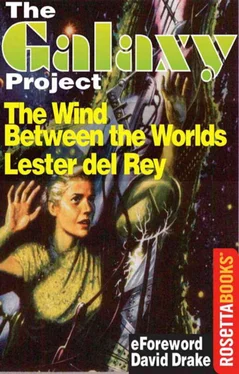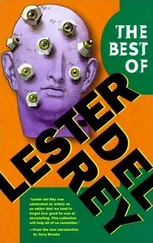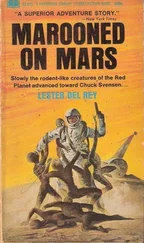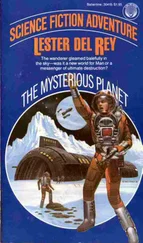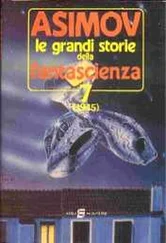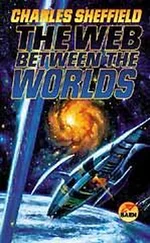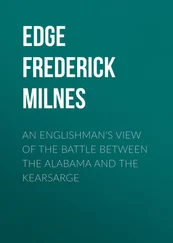Before their eyes, the coal disappeared and a round ball came into existence, suspended in midair. It turned around as if seeking something, an eyelike lens focused on the crowd. Then it darted down and knocked the power plug loose. Nothing could budge it, and no tricks to turn on power again worked.
Even to the businessmen, it was obvious that this object, whatever it was, had not been made on Earth. DuQuesne himself suggested that somewhere some other race must have matter transmittal, and that this was apparently some kind of observer. Man, unable to reach even his own moon yet, had apparently made contact with intelligence from some other world, perhaps some solar system, since there was no theoretical limit to the distance covered by matter transmittal.
It was a week of wild attempts to crack open the “observer” and of futile attempts to learn some-thing about it. Vic’s mind had been filled with Martians, and he had tried to join the thousands who flocked to DuQuesne’s laboratory to see the thing. But his father had been stubborn—no fare for such nonsense. And Vic had had to ‘wait until’ the papers sprang the final surprise, a week later.
The ball had suddenly moved aside and made no effort to stop the machine from operating. When power was turned on, it had disappeared, and this time the Envoy had appeared. There was nothing outlandish about him—he seemed simply a normal man, step-ping out of the crude machine.
In normal English, he had addressed the crowd with the casual statement that he was a robot, designed deliberately to serve as an ambassador to Earth from the Galactic Council. He was simply to be the observer and voice of the Council, which was made up of all worlds having the matter transmitter. They had detected the transmitter radiation, and, by Galactic Law, Earth had automatically earned provisional status. He was here to help set up transmitter arrangements. Engineers from Betz would build transports to six planets of culture similar to Earth’s, to be owned by the Council, as a non-profit business, but manned by Earthmen as quickly as they could be trained.
In return, nothing was demanded, and nothing more was offered. We were a primitive world by their standards, but we would have to work out our own advancement, since they would give no extra knowledge.
He smiled pleasantly to the shocked crowd and moved off with DuQuesne to await results. There were enough, too, from a startled and doubting world. The months that followed were a chaos of news and half-news. The nations were suspicious. There was never something for nothing. The Envoy met the President and Cabinet; he met the United Nations. India walked out; India walked back quickly when plans went ahead blithely without her. Congress proposed tariffs and protested secret treaties. The Envoy met Congress, and somehow overcame enough opposition to get a bare majority.
And the Betz II engineers came on schedule. Man was linked to the stars, though his own planets were still outside his reach. It was a paradox that soon grew stale, but what, actually, would be the point in flying to Mars or Venus when we were in instant touch with the farthest parts of the Galaxy?
There were major wrenches to the economy as our heavy industries suddenly found that other planets could beat them at their work. Plathgol could deliver a perfect Earth automobile, semi-assembled and advanced enough to avoid our patent laws, for twenty pounds of sugar. The heavy industries folded, while we were still experimenting with the business of finding what we had to offer and what we could receive from other worlds. Banks had crashed, men had been out of work. The governments had cushioned the shock, and the new wonders helped to still the voices that suddenly rose up against traffic with alien worlds. But it had been a bitter period, with many lasting scars.
Now a measure of stability had been reached, with a higher standard of living than ever. But the hatreds were pretty deep on the part of those who had been hurt, and others who simply hated newness and change. Vic had done well enough, somehow making his way into the first engineering class out of a hundred thousand applicants. And twelve years had gone by…
Pat’s voice suddenly cut into his thoughts. “All tightened up here, Vic. Wipe the scowl off and let’s go down to check.”
She collected her tools, wrapped her legs around a smooth pole, and went sliding down. He yanked the fan and followed her. Below was the crew. Pat lifted an eyebrow at the grizzled, cadaverous head operator. “Okay, Amos. Plathgol standing by?”
Amos pulled his six-feet-two up from his slump and indicated the yellow stand-by light. Inside the twin poles of the huge transmitter that was tuned to one on Plathgol, a big, twelve-foot diameter plastic cylinder held a single rabbit. Matter transmitting was always a two-way affair, requiring that the same volume be exchanged. And between the worlds, where different atmospheres and pressures were involved, all sending was done in the big capsules. One-way handling was possible, of course, but involved the danger of something materializing to occupy the same space as something else—even air molecules. It wasn’t done except as rigidly controlled experiments.
Amos whistled into the transport-wave interworld phone in the code that was universal between worlds, got an answering whistle, and pressed a lever. The rabbit was gone, and the new capsule was faintly pink, with something resembling a giant worm inside.
Amos clucked in satisfaction. “ Tsiuna. Good eating, only real good we ever got from these things. I got friends on Plathgol that like rabbit. Want some of this, Pat?”
Vic felt his stomach jerk at the colors that crawled over the tsiuna. The hot antiseptic spray was running over the capsule, to be followed by supersonics and ultraviolets to complete sterilization. Amos waited a moment, then pulled out the creature. Pat hefted it.
“Big one. Bring it over to my place and I’ll fry it for you and Vic. How does the Dirac meter read, Vic?”
“On the button.” The seven percent power loss was gone now, after a week of hard work in locating it. “Guess you were right—the reflector was off angle. Should have tried it first, but it never happened before. How’d you figure it out?”
She indicated the interworld phone. “I started out in anthropology. Vic. Got interested in other races, and then found I couldn’t talk to the teleport engineers without being one, so I got sidetracked to this job. But I still talk a lot on anything Galactic policy won’t forbid. When everything else failed, I complained to the Ecthinbal operator that the Betz II boys installed us wrong. I got sympathy instead of indignation, so I figured it could happen. Simple, wasn’t it?”
He snorted, and waited while she gave orders to start business. Then, as the loading cars began to hum, she fell behind him, moving out toward the office. “I suppose you’ll be leaving tonight, Vic. I’ll miss you. You’re the only troubleshooter I’ve met who did more than make passes.”
“When I make passes at your kind of girl, it will be legal. And in my business, it’s no life for a wife.”
But he stopped to look at the building, admiring it for the last time. It was the standard Betz II design, but designed to handle the farm crops around, and bigger than any earlier models on Earth. The Betz II engineers made Earth engineering look childish, even if they did look like big slugs with tentacles and had no sense of sight.
The transmitters were in the circular center, surrounded by a shield ‘wall, a wide hall all around, another shield, a circular hall again, and finally the big outside shield. The two opposite entranceways spiraled through the three shields, each rotating thirty degrees clockwise from the entrance portal through the next shield. Those shields were of inert matter that could be damaged by nothing less violent than a hydrogen bomb directly on them—they refused to soften at less than ten million degrees Kelvin. How the Betzians managed to form them in the first place, nobody knew.
Читать дальше
